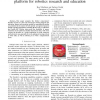Free Online Productivity Tools
i2Speak
i2Symbol
i2OCR
iTex2Img
iWeb2Print
iWeb2Shot
i2Type
iPdf2Split
iPdf2Merge
i2Bopomofo
i2Arabic
i2Style
i2Image
i2PDF
iLatex2Rtf
Sci2ools
ICRA
2007
IEEE
2007
IEEE
Evaluating the Roomba: A low-cost, ubiquitous platform for robotics research and education
— This paper presents the iRobot corporation’s Roomba vacuum as a low-cost resource for robotics research and education. Sensor and actuation models for unmodified Roombas are presented in the context of both special- and general-purpose spatial-reasoning algorithms, including Monte Carlo Localization and FastSLAM. Further tests probe the feasibility of sensor extensions to the platform. Results demonstrate that, with some caveats, the Roomba is a viable foundation for both classroom and laboratory use, especially for work seeking to leverage robots to other ends, as well as robotics per se with a computational focus.
General-purpose Spatial-reasoning Algorithms | ICRA 2007 | Irobot Corporation Roomba | Monte Carlo Localization | Robotics |
| Added | 03 Jun 2010 |
| Updated | 03 Jun 2010 |
| Type | Conference |
| Year | 2007 |
| Where | ICRA |
| Authors | Ben Tribelhorn, Zachary Dodds |
Comments (0)

